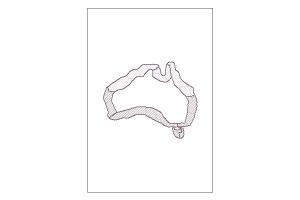OGC:WMS
Type of resources
Keywords
Publication year
Distribution Formats
Service types
Topics
-
This service represents a combination of two data products, the DEM_SRTM_1Second dataset and the Australian_Bathymetry_Topography dataset. This service was created to support the CO2SAP (Co2 Storage application) Project to create a transect elevation graph within the application. This data is not available as a dataset for download as a Geoscience Australia product. The DEM_SRTM_1Second service represents the National Digital Elevation Model (DEM) 1 Second product derived from the National DEM SRTM 1 Second. The DEM represents ground surface topography, with vegetation features removed using an automatic process supported by several vegetation maps. eCat record 72759. The Australian_Bathymetry_Topography service describes the bathymetry dataset of the Australian Exclusive Economic Zone and beyond. Bathymetry data was compiled by Geoscience Australia from multibeam and single beam data (derived from multiple sources), Australian Hydrographic Service (AHS) Laser Airborne Depth Sounding (LADS) data, Royal Australian Navy (RAN) fairsheets, the General Bathymetric Chart of the Oceans (GEBCO) bathymetric model, the 2 arc minute ETOPO (Smith and Sandwell, 1997) and 1 arc minute ETOPO satellite derived bathymetry (Amante and Eakins, 2008). Topographic data (onshore data) is based on the revised Australian 0.0025dd topography grid (Geoscience Australia, 2008), the 0.0025dd New Zealand topography grid (Geographx, 2008) and the 90m SRTM DEM (Jarvis et al, 2008). eCat record 67703. IMPORTANT INFORMATION For data within this service that lays out of the Australian boundary the following needs to be considered. This grid is not suitable for use as an aid to navigation, or to replace any products produced by the Australian Hydrographic Service. Geoscience Australia produces the 0.0025dd bathymetric grid of Australia specifically to provide regional and local broad scale context for scientific and industry projects, and public education. The 0.0025dd grid size is, in many regions of this grid, far in excess of the optimal grid size for some of the input data used. On parts of the continental shelf it may be possible to produce grids at higher resolution, especially where LADS or multibeam surveys exist. However these surveys typically only cover small areas and hence do not warrant the production of a regional scale grid at less than 0.0025dd. There are a number of bathymetric datasets that have not been included in this grid for various reasons.
-

The Australian Coastal Sediment Compartments Web Service provide a hierarchical spatial classification relevant to the assessment of sediment movement in the Australian coastal zone, and represent a tool to assist coastal planning and management. Additional spatial data layers produced during the development of the compartments are provided for reference.
-
The Land Cover map service includes information derived from the Dynamic Land Cover Dataset (2000-2008) containing Enhanced Vegetation Index (EVI) information. The service provides a base-line for identifying and reporting on change and trends in vegetation cover and extent. It is a cached service with a Web Mercator Projection.
-
The data contained in this service is not authoritative and has not been updated since 2006. This web service contains the legacy data found in the Australian Marine Spatial Information System (AMSIS) between 2006 and 2015, with a currency date of 2006. To honour the original licensing arrangements with the data holders, only the WMS is available. Users will need to contact the agency responsible for the data to check current validity and spatial precision.
-
The service contains the 2013 Earthquake Hazard map, as a raster and contours. This map shows the peak ground acceleration (response spectral period of 0.01 seconds) on rock expected for a 500 year return period, in units of g, evaluated for the geometric mean of the horizontal components. The map is the closest in return period and response spectral period to the current earthquake hazard map in the Australian Standard AS1170.4-2007.
-
This service provides access to airborne electromagnetics (AEM) derived conductivity grids in the Upper Darling Floodplain region. The grids represent 30 depth intervals from modelling of AEM data acquired in the Upper Darling Floodplain, New South Wales, Airborne Electromagnetic Survey (https://dx.doi.org/10.26186/147267), an Exploring for the Future (EFTF) project jointly funded by Geoscience Australia and New South Wales Department of Planning and Environment (NSW DPE). The AEM conductivity model delineates important subsurface features for assessing the groundwater system including lithological boundaries, palaeovalleys and hydrostatigraphy.
-
OPGGSA 2006 - Petroleum Blocks. This service displays the most recent realisation of the Petroleum Blocks as defined under Section 33 (3) of the Offshore Petroleum and Greenhouse Gas Storage Act 2006 (OPGGSA 2006) as realised in GDA94. Block data extends beyond the area of operation of the OPGGSA and includes areas of coastal waters and land within the constitutional limits of the States and Territories.
-
The Australian Lithospheric Architecture Magnetotelluric Project (AusLAMP) aims to collect long period magnetotelluric data on a half degree (~55 km) grid across the Australian continent. New datasets have been collected in Northern Australia, as part of Geoscience Australia’s Exploring for the Future (EFTF) program with in-kind contributions from the Northern Territory Geological Survey and the Geological Survey of Queensland. This web service depicts the location of the 155 sites which were used in this study.
-
This service is the processing inputs that are used within the Route Planning geoprocessing service. This service is specifically for use within the Carbon Capture and Storage application.
-
The Australian Geothermal Association compiled data on the installed capacity of direct-use geothermal and geoexchange systems in Australia, including large-scale ground source heat pumps and hot sedimentary applications through to December 2018. Large-scale direct-use hot sedimentary aquifer systems includes systems to heat swimming pools or provide hydronic heating systems. In geoexchange systems, the Earth acts as a heat source or a heat sink, exploiting the temperature difference between the surface (atmosphere) and at depth. The temperature of the Earth just a few metres below the surface is much more consistent than atmospheric temperature, especially in seasonal climates. These resources do not require the addition of geothermal heat.
